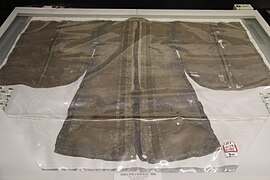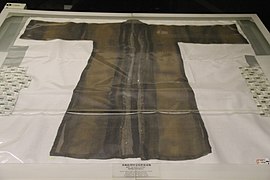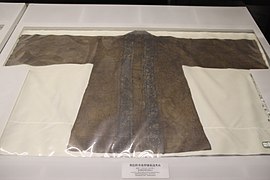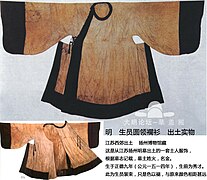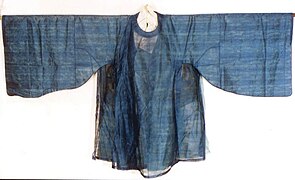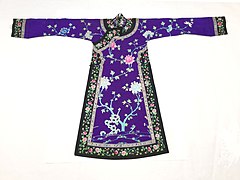Garment collars in hanfu

Garment collars in hanfu are diverse and come in several shapes,[1] including jiaoling (cross-collars, overlapping collars at the front which closed on the right or left sides), duijin, yuanling, liling, fangling, tanling. Some forms of collars were indigenous to China while others had been adopted from the Hufu of other non-Han Chinese ethnic minorities and/or from the clothing worn by foreigners.
Cultural significance[edit]
Ru[edit]
Youren (right lapel)[edit]

Chinese robes, such as the shenyi and the paofu as a general term, as well as Chinese jackets must typically cover the right part of their garment.[2] Styles of garments which overlapping at the front and closes to the right side are known as youren (Chinese: 右衽; lit. 'right lapel'). The youren closure is a style which originated in China and can be traced back to the Shang dynasty.[3] The youren is also an important symbol of the Han Chinese ethnicity.[2] The youren closure was eventually adopted by other ethnic minorities and was also spread to neighbouring countries, such as Vietnam, Korea and Japan.
Zuoren (left lapel)[edit]
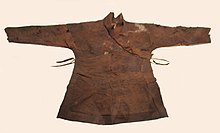
Chinese people also wore another form of closure known as zuoren (Chinese: 左衽; lit. 'left lapel'), which generally refers the way garment overlaps on the front, like the youren closure, but instead closes on the left side.[2] According to the Shuowen Jiezi 《說文解字》, a form of paofu, known as xi (襲), was a robe with a zuoren closure[4][5] while the coat known as zhe (褶; sometimes also referred as xi), typically used as part of the kuzhe, was also a xi (襲) according to the Shiming.[6]
The use of zuoren, however, was typically associated with funeral practices. This can also be found in the chapter Sang da ji (喪大記) of the Liji (禮記):
"At both the dressings the sacrificial robes were not placed below the others. They were all placed with the lapel to lie on the left side. The bands were tied firmly, and not in a bow-knot [小斂大斂,祭服不倒,皆左衽結絞不紐]."
According to ancient Chinese beliefs, the only moment the Han Chinese were supposed to use zuoren was when they dressed their deceased.[2] This funeral practice was rooted in ancient Chinese beliefs; especially in the Yin and Yang theory, where it is believed that the left side is the Yang and stands for life whereas the right side is the Yin which stands for death.[7]

Therefore, according to the Yin and Yang theory, the left lapel of a garment needs to be found outside (which is in the form of youren closure) to indicate that the power of the Yang aspect is suppressing the Yin aspect, which thus symbolizes the clothing of living people.[7] On the other hand, the zuoren is a representation of the Yin aspect surpassing the Yang aspect, and thus, garments with a zuoren closure became the clothing worn by the deceased.[7] It was therefore a taboo in Chinese clothing culture for a living person to wear clothing with a zuoren closure.[7]
There are exceptions in which living Han Chinese would wear clothing with a zuoren closure. For example, in some areas (such as Northern Hebei) in the 10th century, some ethnic Han Chinese could be found wearing left-lapel clothing.[8] It was also common for the Han Chinese women to adopt left lapel under the reign of foreign nationalities, such as in the such as in the Yuan dynasty.[9] The practice of wearing the zuoren also continued in some areas of the Ming dynasty despite being a Han Chinese-ruled dynasty which is an atypical feature.[9]
Association with ethnic minorities and foreigners[edit]

The zuoren closure was also associated with the clothing of non-Han Chinese, ethnic minorities, and foreigners in ancient times. Some ethnic minorities generally had their clothing closing in the zuoren-style[2] according to what was recorded in ancient Chinese texts, such as the Qiang.[10]: 101 As a result, the traditional way to distinguish between clothing of the "Barbarian" (i.e. non-Han Chinese), Hufu, and Chinese clothing, hanfu, was typically by looking at the direction of the collar.[11]
This can also be found in the Analects where Confucius himself praised Guan Zhong for preventing the weakened Zhou dynasty from becoming barbarians:[12][13][14]
"But for Guan Zhong, we should now be wearing our hair unbound [pifa], and the lapels of our coats buttoning on the left side [zuoren]. [微管仲,吾其被髮左衽矣]."
Based on Confucius' sayings, pifa zuoren (simplified Chinese: 被发左衽; traditional Chinese: 被髮左衽; pinyin: bèifà zuǒrèn; lit. 'unbound hair left lapel'), bound hair and coats which closed on the left side, was associated with the clothing customs of the northern nomadic ethnic groups who were considered as barbarians.[12] From the standpoint of the Huaxia culture, pifa was a way to reject refined culture and being turned into a barbarian.[10]: 101
By the Han dynasty, since Confucius himself was the first person to use the phrase pifa zuoren to refer to Non-Zhou dynasty people, this phrase became a common metaphor for primitiveness.[10]: 103 When used by the ancient Chinese literati, the concept of pifa zuoren became a phrase, which held the symbolic of foreign people who were living a barbarous and civilized lifestyle; this concept also became a way to emphasize the customs differences between the Han people and other ethnic minorities and draw the line to distinguish who was were considered as civilized and barbarians.[10]: 103 The zuoren thus also became a reference to Hufu and/or to the rule of foreign nationalities.[2] Of note, some non-Chinese ethnicity who adopted Hanfu-style sometimes maintain their left lapels, such as the Khitans in the Liao dynasty.[15]: 267
Common types of collar[edit]
Cross-collars[edit]
Jiaoling youren[edit]

Jiaoling youren (Chinese: 交領右衽) were cross-collars which overlapped on the front and closed on the right side following the youren (右衽) rule;[16] they can also be described as cross-collar garments closing to the right side, or y-shaped collar. The jiaoling youren started to be worn in the Shang dynasty in China.[17][18] This form of collar eventually became one of the major symbols of the Sino Kingdoms[16] and eventually spread throughout Asia.[18] Garments and attire which used the jiaoling youren collar include: shenyi, jiaolingpao, mianfu, pienfu, diyi, dahu, and tieli.
Jiaoling zuoren[edit]

Jiaoling zouren refers to the cross-collars which closes on the left side instead of the right side. They were typically used by non-Han Chinese ethnicities in ancient China, but were also adopted by the Han Chinese in some circumstances, e.g. when they were ruled by non-Han Chinese rulers. Han Chinese women were also found sometimes found in the paintings of the Ming dynasty, which is an atypical feature.[9] They were also used to dress the deceased of the Han Chinese.[2]
Central front collars[edit]
Collars which runs parallel and straight at the front are called duijin (对襟).[19][20]: 22 Garments with duijin collars can either be closed at the centre front[20]: 22 [21] or be left opened in the front.[19] They could be found with or without a high collar depending on the time period.[1] Duijin could be used in garments and attire, such as beizi, banbi, and beixin.
-
Daxiushan with duijin collar, Song dynasty
-
Beizi with duijin collar, Song dynasty
-
Shan with duijin collar, Song dynasty
-
Beixin with duijin collar, Song dynasty
-
Duijin shan, Qing dynasty
Round collars[edit]

Round collars are called yuanling (圆领)[1] or panling (盘领).[22][23] In ancient China, clothing with round collars were typically introduced and/or influenced by foreign ethnicities, such as the Donghu,[24][25] the Wuhu,[24][26]: 317 and the foreigners from Central Asia, such as the Sogdians,[27][28] and the Mongols,[25] at different point in time. Yuanling can be overlapping to the right or closing at the front in the duijin manner.[1][29] Yuanling could be used in garments and attire, such as yuanlingshan, yuanlingpao, panling lanshan, and wulingshan (无领衫).[29]
-
Yuanlingshan closing on the right, Ming dynasty
-
Panling lanshan, Ming dynasty
-
Yuanlingshan closing on the right, Ming dynasty
-
Yuanling banbi, which closes at the front in a duijin manner.
-
Qing dynasty
-
Yuanling shan, Qing dynasty.
Standing collars[edit]

High standing collars in the Ming dynasty are referred as shuling (竖领) or liling (立领).[1] They appeared by the late Ming dynasty.[30]: 93 There were two main forms of high standing collars garments based on their types of lapels and closure.[1]
Standing collar with right closure[edit]
Clothing with shuling dajin (竖领大襟), also called liling dajin or shuling xiejin or liling xiejin, has a standing collar and a large lapel which closes on the right.[29] The dajin placket is also called xiejin (Chinese: 斜襟; pinyin: xiéjīn; lit. 'slanted placket').
- Shuling dajin
-
Shuling dajin, High collar with overlapping front, Ming dynasty
-
Shuling dajin, High collar with overlapping front, Ming dynasty
Standing collar with central front closure[edit]
Clothing with shuling duijin (or liling (or shuling) duijin) has a standing collar and closes with a central front closure.[1]
Other forms of collars[edit]
Lapel collars[edit]
Fanling refers to the lapel collars, typically categorized as Hufu-style collars
Square collars[edit]
Square collars are referred as fangling (方领).[4]: 166 [1]
-
Fangling ao, Ming dynasty
-
Zhaojia (罩甲) with square collar, Ming dynasty
U-shaped collar[edit]
U-shaped collar are known as tanling (Chinese: 坦领; pinyin: tǎnlǐng; lit. 'flat collar/ open-hearted collar').[31] Tanling could be used in garments and attire, such as tanling banbi and tanling ruqun.
Pipa-shaped collar[edit]
Pianjin (Chinese: 偏襟; pinyin: piānjīn; lit. 'slanted placket'), also called Pipa-shaped collars and sometimes referred as 'slanted' collar in English,[21] were form of collars which overlaps and closes to the right side with a big lapel.[21] This form of collar was influenced by the Manchu clothing.[21] The Manchu's front overlap opening was a Manchu innovation; their clothing was closed with buttons on the centre front of the neck, right clavicle, and under the right arm along the right seams.[32] The Manchu overlap was more shaped like an S-curved overlap; it ran straight to the right of the centre-front of the neck, drops down to the burst before curving to the right side.[33]: 63 The Manchu's garments rarely showed high collars until the 20th century.[30]: 93 The Pip-shaped collar were worn in the Qing dynasty and the Republic of China.[34][21] It could be found without or with a high collar (e.g. mandarin collar).[21]
-
Pipa-shaped collar in Han woman ao (jacket), Qing dynasty
-
The collar of this ao (jacket) was influenced by the pipa-shaped collar, Qing dynasty
-
Manchu pipa-collar, Qing dynasty
-
Manchu pipa-collar, Qing dynasty
-
Manchu pipa-collar, Qing dynasty
See also[edit]
Notes[edit]
References[edit]
- ^ a b c d e f g h "Guide of the Ming Dynasty Shan/Ao Types for Girls - 2022". www.newhanfu.com. 2021-07-02. Retrieved 2022-05-26.
- ^ a b c d e f g Ma, Xiaofang (2018). "Study on the Aesthetics of Han Chinese Clothing Culture in the TV Play q Nirvana in Fireq". Proceedings of the 3rd International Conference on Contemporary Education, Social Sciences and Humanities (ICCESSH 2018). Atlantis Press. pp. 639–643. doi:10.2991/iccessh-18.2018.143. ISBN 978-94-6252-528-3.
- ^ Yu, Song-Ok (1980). "A Comparative Study on the Upper Garment in the Ancient East and West". Journal of the Korean Society of Costume. 3: 29–46. ISSN 1229-6880.
- ^ a b Zhang, Weiwei (2016). Variation in metonymy : cross-linguistic, historical and lectal perspectives. Berlin. ISBN 978-3-11-045583-0. OCLC 947083957.
{{cite book}}: CS1 maint: location missing publisher (link) - ^ "說文解字「襲」". www.shuowen.org. Retrieved 2022-07-11.
- ^ "Shiming《釋衣服》". ctext.org. Retrieved 2022-07-11.
- ^ a b c d Shi, Songge (2021). "Travelling With Hanfu: A Social Media Analysis of Contemporary Chinese Travelling for Artistic Photographs".
{{cite journal}}: Cite journal requires|journal=(help) - ^ Zhang, Ling (2016). The River, the Plain, and the State: An Environmental Drama in Northern Song China, 1048-1128. Cambridge: Cambridge University Press. doi:10.1017/cbo9781316659298.002. ISBN 978-1-316-65929-8.
- ^ a b c The Museum of Far East Antique Bulletin 70. Östasiatiska museet. 1998. p. 208.
- ^ a b c d Tse, Wicky W. K. (2018). The collapse of China's later Han Dynasty, 25-220 CE : the northwest borderlands and the edge of empire. London. ISBN 978-1-315-53231-8. OCLC 1042329243.
{{cite book}}: CS1 maint: location missing publisher (link) - ^ Xu, Jing (2016). A Chinese traveler in medieval Korea : Xu Jing's illustrated account of the Xuanhe embassy to Koryo. Sem Vermeersch. Honolulu. pp. 331–332. ISBN 978-0-8248-6683-9. OCLC 950971983.
{{cite book}}: CS1 maint: location missing publisher (link) - ^ a b Kang, Chae-ŏn (2006). The land of scholars : two thousand years of Korean Confucianism. Suzanne Lee (1st ed.). Paramus, New Jersey. ISBN 1-931907-30-7. OCLC 60931394.
{{cite book}}: CS1 maint: location missing publisher (link) - ^ Dress and ideology : fashioning identity from antiquity to the present. Shoshana-Rose Marzel, Guy Stiebel. London. 2015. p. 41. ISBN 978-1-4725-5808-4. OCLC 895162445.
{{cite book}}: CS1 maint: location missing publisher (link) CS1 maint: others (link) - ^ "論語 : 憲問 - 微管仲,吾其被髮左衽矣。 - 中國哲學書電子化計劃". ctext.org (in Chinese (Taiwan)). Retrieved 2022-02-07.
- ^ Kuhn, Dieter (2009). The age of Confucian rule : the Song transformation of China. Cambridge, Mass.: Belknap Press of Harvard University Press. ISBN 978-0-674-03146-3. OCLC 192050158.
- ^ a b Ho, Wei; Lee, Eun-Young (2009). "Modem Meaning of Han Chinese Clothing(韓服)". Journal of the Korea Fashion and Costume Design Association. 11 (1): 99–109. ISSN 1229-7240.
- ^ Zhao, Yin (2014). Snapshots of Chinese culture. Xinzhi Cai. Los Angeles. ISBN 978-1-62643-003-7. OCLC 912499249.
{{cite book}}: CS1 maint: location missing publisher (link) - ^ a b Kidd, Laura K.; Lee, Younsoo (2002). "The Style Characteristics of the Hwalot, with a Focus on One Robe from the Collection of the Honolulu Academy of Arts". Clothing and Textiles Research Journal. 20 (1): 1–14. doi:10.1177/0887302x0202000101. ISSN 0887-302X. S2CID 110839493.
- ^ a b "Ancient Chinese Fashion: Historical Prototype of Hanfu Style". www.newhanfu.com. 2020-10-14. Retrieved 2022-05-26.
- ^ a b Silberstein, Rachel (2020). A fashionable century : textile artistry and commerce in the late Qing. Seattle. ISBN 978-0-295-74719-4. OCLC 1121420666.
{{cite book}}: CS1 maint: location missing publisher (link) - ^ a b c d e f Jiang, Wanyi; Li, Zhaoqing (2021-01-06). "Analysis on Evolution, Design and Application of Women's Traditional Coats in Beijing in the Late Qing Dynasty and the Early Republic of China: Based on the Collection of Ethnic Custom Museum of Beijing Institute of Fashion Technology". Proceedings of the 6th International Conference on Arts, Design and Contemporary Education (ICADCE 2020). Atlantis Press. pp. 641–648. doi:10.2991/assehr.k.210106.123. ISBN 978-94-6239-314-1. S2CID 234293619.
- ^ 유혜영 (1992). 돈황석굴벽화에 보이는 일반복식의 연구 (Doctoral Thesis). 이화여자대학교 대학원.
- ^ "Hanfu Making(5) - Pan Collar Aoqun Cutting & Sewing Patterns - 2022". www.newhanfu.com. 2021-06-17. Retrieved 2022-05-26.
- ^ a b Wang, Fang (2018). "Study on Structure and Craft of Traditional Costumes of Edge" (PDF). Proceedings of the 2nd International Conference on Economics and Management, Education, Humanities and Social Sciences (EMEHSS 2018). Atlantis Press. pp. 584–588. doi:10.2991/emehss-18.2018.118. ISBN 978-94-6252-476-7.
- ^ a b Yang, Shuran; Yue, Li; Wang, Xiaogang (2021-08-01). "Study on the structure and virtual model of "xiezhi" gown in Ming dynasty". Journal of Physics: Conference Series. 1986 (1): 012116. Bibcode:2021JPhCS1986a2116Y. doi:10.1088/1742-6596/1986/1/012116. ISSN 1742-6588. S2CID 236985886.
- ^ Dien, Albert E. (2007). Six dynasties civilization. New Haven, Conn.: Yale University Press. ISBN 978-0-300-07404-8. OCLC 72868060.
- ^ Zhao, Qiwang (2020). "Western Cultural Factors in Robes of Wei, Jin, Southern and Northern Dynasties as Well as Sui and Tang Dynasties" (PDF). 2020 3rd International Conference on Arts, Linguistics, Literature and Humanities (ICALLH 2020). Francis Academic Press, UK: 141–147. doi:10.25236/icallh.2020.025 (inactive 31 January 2024).
{{cite journal}}: CS1 maint: DOI inactive as of January 2024 (link) - ^ Zhao, Qiwang (2019). "The Origin of Partial Decorations in Gowns of the Northern Qi and Tang Dynasties". 2nd International Conference on Cultures, Languages and Literatures, and Arts: 342–349.
- ^ a b c "Guide to Hanfu Types Summary & Dress Codes (Ming Dynasty)". www.newhanfu.com. 2021-04-04. Retrieved 2022-06-13.
- ^ a b Finnane, Antonia (2007). Changing clothes in China : fashion, history, nation. London: Hurst & Co. ISBN 978-1-85065-860-3. OCLC 166381500.
- ^ 王金妍 (29 July 2019). "Hanfu: China's traditional Han-style clothing". www.chinastory.cn. Retrieved 2022-05-26.
- ^ "Turn back your cuffs". John E. Vollmer. 2017-10-16. Retrieved 2022-05-26.
- ^ Bonds, Alexandra B. (2008). Beijing opera costumes : the visual communication of character and culture. Honolulu: University of Hawaiʻi Press. ISBN 978-1-4356-6584-2. OCLC 256864936.
- ^ "Women's Clothing Changes During the Ming and Qing Dynasties". www.newhanfu.com. 2021-02-14. Retrieved 2022-05-26.

